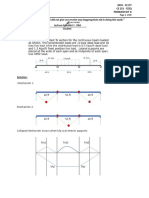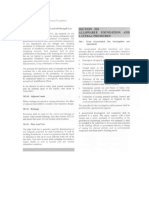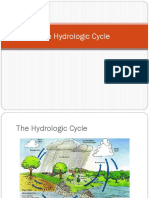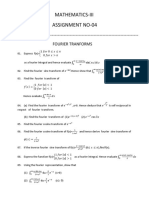Drained Vs Undrained Loadings in Geotechnical Engineering: Siva Sivakugan
Uploaded by
Jashwin UllalDrained Vs Undrained Loadings in Geotechnical Engineering: Siva Sivakugan
Uploaded by
Jashwin UllalDrained vs Undrained Loadings
in Geotechnical Engineering
• Published on June 18, 2014
Siva Sivakugan
n in to follow this a
One thing that takes a while for the budding geotechs to digest is the
difference between undrained and drained parameters, and when to
use what. Actually, it is simple and is common sense. When a
saturated clay is loaded, it will not let the water out immediately (i.e.
remains undrained) and that is when most of the failures occur. In the
short-term, the clay can be treated as an undrained homogeneous
material where we will not separate the grains and water. Here, we
carry out the undrained analysis in terms of total stresses, using
undrained shear strength cu ( = 0).
In the long term (after some months or years), the clay will drain out
some water until the excess pore water pressure is fully dissipated and
the pore water pressure is in equilibrium with the in-situ conditions.
Now, it is prudent to carry out an effective stress analysis using c' and
', where we separate the stresses acting on the pore water (pore water
pressure) and the grains (effective stresses).
Undrained analysis is often much easier to carry out, inexpensive to
get the design parameters, and is necessary to assess the short-term
stability which can be more critical than the long-term stability. For
undrained loading, the failure envelope in terms of total stresses is
horizontal and hence we only need one parameter, undrained cohesion
cu ( = 0). Undrained cohesion can be derived from an unconfined
compression test, UU triaxial, vane shear test (lab or field) or simply
using a pocket penetrometer. Drained analysis needs c' and ' which
are derived from more expensive consolidated drained or undrained
triaxial tests or in situ tests (and estimated using correlations). They
are necessary when working with effective stresses. We generally
charge A$1500-A$2000 (2014) for a CD or CU triaxial test on three
specimens at different confining pressures, while an unconfined
compression test costs less than A$100.
Granular soils drain very quickly, and hence they are always treated
as drained and analysed in terms of effective stresses using ' (c'=0).
For normally consolidated clays c' = 0. Even for other clays
(compacted or overconsolidated), c' is not very large and is in the
order of 0-25 kPa. Danish code suggests that c' can be taken as 0.1Cu.
In summary,
Short-term analysis is carried out in terms of total
stresses, using undrained shear strength parameters
Cu and = 0.
Long-term analysis is carried out in terms of effective
stresses, using drained shear strength parameters c'
and phi'.
You might also like
- Soil Parameters For Drained and Undrained Analysis100% (3)Soil Parameters For Drained and Undrained Analysis48 pages
- CE297 Discussion Questions - ARUP - Building The Water CubeNo ratings yetCE297 Discussion Questions - ARUP - Building The Water Cube5 pages
- Drained Vs Undrained Loadings in Geotechnical EngineeringNo ratings yetDrained Vs Undrained Loadings in Geotechnical Engineering3 pages
- On The Use of Soil Drained and Undrained ParametersNo ratings yetOn The Use of Soil Drained and Undrained Parameters4 pages
- On The Use of Soil Drained and Undrained Parameters100% (1)On The Use of Soil Drained and Undrained Parameters5 pages
- N) - The Blow Count Is: 5.5 Drained and Undrained Loading Conditions Via FemNo ratings yetN) - The Blow Count Is: 5.5 Drained and Undrained Loading Conditions Via Fem9 pages
- Slope Stability and Soil/rock Strength: Lab TestsNo ratings yetSlope Stability and Soil/rock Strength: Lab Tests10 pages
- 2016_A Procedure for the Assessment of the Undrained Shear Strenght Profile of Soft Clays_Vikas ThakurNo ratings yet2016_A Procedure for the Assessment of the Undrained Shear Strenght Profile of Soft Clays_Vikas Thakur15 pages
- Undrained Young 'S Modulus of Fine-Grained SoilsNo ratings yetUndrained Young 'S Modulus of Fine-Grained Soils8 pages
- Soil Parameters Used To Measure Shear StrengthNo ratings yetSoil Parameters Used To Measure Shear Strength2 pages
- Prediction of Undrained Shear Strength and CorrelaNo ratings yetPrediction of Undrained Shear Strength and Correla9 pages
- Total Stress Analysis Vs Effective Stress AnalysisNo ratings yetTotal Stress Analysis Vs Effective Stress Analysis2 pages
- CE 154 Foundation Engineering Topic 1d ContinuationNo ratings yetCE 154 Foundation Engineering Topic 1d Continuation7 pages
- Rak-50 3149 F. l6 - Drained Undrained AnalysisNo ratings yetRak-50 3149 F. l6 - Drained Undrained Analysis43 pages
- Lecture 11 - Modelling of Soil BehaviourNo ratings yetLecture 11 - Modelling of Soil Behaviour22 pages
- Navigation & Voyage Planning Companions: Navigation, Nautical Calculation & Passage Planning CompanionsFrom EverandNavigation & Voyage Planning Companions: Navigation, Nautical Calculation & Passage Planning CompanionsNo ratings yet
- Ullal, Jashwin Benedict-Probset-D-Ce252No ratings yetUllal, Jashwin Benedict-Probset-D-Ce25220 pages
- TABLE: Story Drifts Story Load Case/Combo Direction Drift Label X Y ZNo ratings yetTABLE: Story Drifts Story Load Case/Combo Direction Drift Label X Y Z12 pages
- CE297 Discussion Questions - Quadrant Homes: Adapting A Lean OperatingNo ratings yetCE297 Discussion Questions - Quadrant Homes: Adapting A Lean Operating1 page
- Discussion of ACME Medical Imaging Company Case StudyNo ratings yetDiscussion of ACME Medical Imaging Company Case Study3 pages
- 2991L Foundations 1: Shallow Footing in Clay Soil Skempton's Chart Allowable Bearing Capacity Coulomb's Failure Envelop100% (1)2991L Foundations 1: Shallow Footing in Clay Soil Skempton's Chart Allowable Bearing Capacity Coulomb's Failure Envelop24 pages
- 3 SPT Correlations, Peck Et Al. 1953 PDFNo ratings yet3 SPT Correlations, Peck Et Al. 1953 PDF2 pages
- Specific Gravity Determination: Density BottleNo ratings yetSpecific Gravity Determination: Density Bottle4 pages
- A Comparative Study of Design Base Shear For RC Buildings in Selected Seismic Design CodesNo ratings yetA Comparative Study of Design Base Shear For RC Buildings in Selected Seismic Design Codes25 pages
- Installation of Underground Columns For Mitigation of Seismic LiquefactionNo ratings yetInstallation of Underground Columns For Mitigation of Seismic Liquefaction13 pages
- Wind Simulation in Robot Structural Analysis Professional: Learning ObjectivesNo ratings yetWind Simulation in Robot Structural Analysis Professional: Learning Objectives16 pages
- Integrating Structural Design and Analysis: The Basics of A Revit-Robot Structural Analysis WorkflowNo ratings yetIntegrating Structural Design and Analysis: The Basics of A Revit-Robot Structural Analysis Workflow18 pages
- A Study of The Various Structural Framing Systems Subjected To Seismic LoadsNo ratings yetA Study of The Various Structural Framing Systems Subjected To Seismic Loads8 pages
- Ren153@purdue - Edu Jiansong-Zhang@purdue - Edu Hdib@purdue - Edu: BIM Interoperability For Structure AnalysisNo ratings yetRen153@purdue - Edu Jiansong-Zhang@purdue - Edu Hdib@purdue - Edu: BIM Interoperability For Structure Analysis10 pages
- Weebly - Pink Wachirapaet - Traveling Water Lab Report - Summative Assessment U4 g8No ratings yetWeebly - Pink Wachirapaet - Traveling Water Lab Report - Summative Assessment U4 g85 pages
- Modeling, Simulation and Scale-Up of A Batch Reactor: René O. Vargas and Francisco López-SerranoNo ratings yetModeling, Simulation and Scale-Up of A Batch Reactor: René O. Vargas and Francisco López-Serrano7 pages
- Effect of The Thickness of The PT Film Coated On A Counter Electrode On The Performance of A Dye-Sensitized Solar CellNo ratings yetEffect of The Thickness of The PT Film Coated On A Counter Electrode On The Performance of A Dye-Sensitized Solar Cell7 pages
- Calculation of Load Carrying Capacity of Pile (Al)No ratings yetCalculation of Load Carrying Capacity of Pile (Al)26 pages
- PulsarPhotonics MultiBeamScanner Chinese 2014No ratings yetPulsarPhotonics MultiBeamScanner Chinese 20144 pages
- (Disque) A Note On Safety-Relevant Vibrations Induced by Brake SquealNo ratings yet(Disque) A Note On Safety-Relevant Vibrations Induced by Brake Squeal6 pages
- A Generalized Flow Prediction Method For The Unsteady Flow Generated by A Train in A Single-Track TunnelNo ratings yetA Generalized Flow Prediction Method For The Unsteady Flow Generated by A Train in A Single-Track Tunnel30 pages
- H. R. Vallentine (Auth.) - Applied Hydrodynamics-Springer US (1967) PDFNo ratings yetH. R. Vallentine (Auth.) - Applied Hydrodynamics-Springer US (1967) PDF305 pages
- Wind-Tunnel Techniques: by Sangram SamalNo ratings yetWind-Tunnel Techniques: by Sangram Samal54 pages
- The Effect of Bed Roughness On Velocity ProfileNo ratings yetThe Effect of Bed Roughness On Velocity Profile7 pages
- Theoretical Basics of Experimental Phenomena100% (1)Theoretical Basics of Experimental Phenomena23 pages
- PSV 0764 CD Vent KO Drum Liquid Pump - L03No ratings yetPSV 0764 CD Vent KO Drum Liquid Pump - L033 pages
- Reinforced Concrete Design Column Interaction DiagramNo ratings yetReinforced Concrete Design Column Interaction Diagram15 pages
















































































































